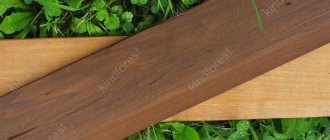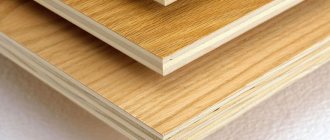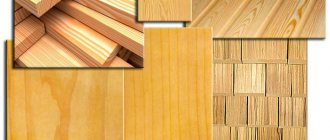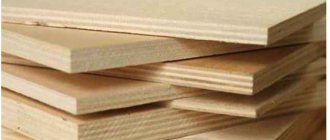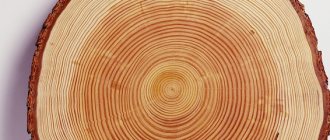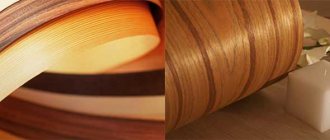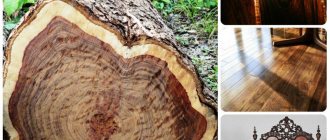Wood is rightfully considered the most popular, safe and environmentally friendly material. Unlike brick, concrete and other synthetic materials, wood is susceptible to deformation, rot, mold and other negative phenomena. To prevent this from happening, the wood is treated with special compounds, but there is also so-called thermal wood.
This is a special type of wood that has been treated not with chemicals, but with high temperature. This material is often called superwood or the material of the 21st century. What this is will be discussed in more detail in this article. From it the reader will learn how thermowood is made, what it is used for and how it is used in construction. As additions, the article contains photographs and several videos on the chosen topic, and the reader is also offered interesting material for downloading.
What is thermowood.
Coloring and toning
Almost all types of thermowood have a distinct beautiful texture, the coating of which with a special composition gives a truly unique appearance. There are two types of such processing - tinting and coloring.
Material on the topic: what is laminated chipboard.
Toning
It is produced using Lazuri - this is a unique composition, the basis of which is a mixture of natural oils and purified turpentine. Glaze is an almost transparent coating; it slightly changes the shade of wood and emphasizes its natural beauty. It should be remembered that this is a finishing coating that is applied to the treated surface in several layers. It has not only decorative, but also protective properties.
Azure tinting is used. For this, certain pigments are used. This coating allows you not only to emphasize the texture, but also to slightly change the shade of the wood, making it most suitable for a particular interior.
Tinted thermowood.
Coloring
Painting thermowood using special paint is also widely practiced. In this case, the paint is also transparent enough so as not to cover the very texture of the fibers, and at the same time, give a certain shade. Just like azure, it is used for design solutions and serves as additional protection for external and internal structures and furniture.
Painted thermowood.
Properties of thermally modified wood
It is a natural, absolutely environmentally friendly material and has a number of unique properties compared to conventional ornamental and construction wood:
- low equilibrium humidity at the level of 4-8%, which is 4-6 times lower than after conventional industrial drying;
- resistance to decay (due to high processing temperatures, polysaccharides decompose in the wood, which, against the background of low equilibrium humidity, eliminates the conditions for the occurrence and reproduction of fungus, mold and any microorganisms);
- stable geometry of products in operation, regardless of changes in temperature and humidity (the risk of swelling is reduced to 90%);
- the ability to give cheap types of wood the appearance of exotic species and antique wood and obtain any shades from light yellow to almost black (regardless of the type of wood) throughout the entire depth of the product;
- improving the thermal insulation properties of wood by 30%, which makes thermowood an ideal material for saunas, baths and interior cladding of houses;
- low hygroscopicity (moisture absorption is reduced by 5 times);
- reduced thermal conductivity and high structure density;
- lighter weight than wood dried in drying chambers; • low resin content in the composition of conifers;
- biological durability;
- environmental friendliness (heat treatment does not involve the introduction of any chemical additives, only steam and temperature, as a result of which the product remains environmentally friendly).
Properties of thermally modified wood.
Thermowood price
Our technology allows us to produce a high-quality product at minimal costs. The main cost item in production is electricity costs.
The main factors influencing the price of thermowood:
- Wood species.
- Wood type
- Product dimensions.
As is the case with ordinary wood, boards made from inexpensive and common species (pine, larch) are inexpensive. The price of materials and finished products made from ash, oak, birch or cedar is much higher.
Prices for thermowood (valid from 01/01/2015)
Wood heat treatment technology
Standard processing technology (changes are possible depending on the manufacturer of thermowood decking boards):
- Drying. In a special oven, the temperature is maintained at 100-130ºC for a long time, and steam treatment is performed. Drying continues until all moisture is removed from the wood.
- Heat treatment. Increasing the temperature in the oven - up to 180-240ºС, depending on the type of wood. The protective steam environment prevents fire and modifies the chemical composition of the wood. Heat treatment lasts up to 3 hours.
- Cooling. Having passed the peak value, the temperature gradually decreases with the drip irrigation system. At around 80-90ºС the thermowood is moistened. The ideal residual moisture content is 4-7%. Cooling takes 5-15 hours.
Expert opinion
Ostakhov Alexey Mikhailovich
Practical experience, higher construction education. I talk about repairs and construction in clear language
Ask a Question
No formaldehydes, plasticizers or modifiers are used during the processing: natural thermal wood remains environmentally friendly and retains all its beneficial properties. The raw materials for thermowood are ordinary wood species that have undergone a thermal treatment process, the essence of which is the production impact of high temperatures on known wood species.
Speaking about thermowood, the production of which is by no means know-how, it should be noted that the technology for its production consists of stepwise heating of wood to 210 degrees under constant pressure. This process is called hydrothermal treatment and involves three constant components: high temperatures, wood and water.
Application of thermowood.
Innovative developments and biochemical manipulations
Previously, wood was treated with chemicals that protected the material from the damaging effects of mold and rot. But this option implies the possibility of certain harm to the body caused by chemical reagents. Innovative technologies have long moved forward, and developers have proposed a new way to modify a material so common in construction.
Question to the expert
Why doesn't thermowood lose strength after processing?
The structural composition of wood includes cellulose and hemicellulose, biochemical manipulation of which is the basis for the production of thermally modified wood. During the manufacturing process of thermowood, the technology of which involves biochemical changes in the structure of wood, hemicellulose decomposes, while the molecular structure of cellulose remains constant.
READ What does a sycamore tree look like?
This is the main way to improve the performance of previously unstable wood. Less importance in this process is given to the evaporation of wood extractives, as well as reactive components that are exposed to chemical action.
Production of thermally modified wood.
Other production methods
The process of making thermal wood is quite simple - essentially it is subjected to prolonged exposure to temperature, causing it to become hollow. In the sense that the cellulose in it partially burns out, all the existing resins come out and the structure of the fibers themselves changes - the tree is, as it were, caramelized, due to which it acquires very high performance, which is why it is valued. Heat treatment of wood can be done in four different ways.
- Single-stage treatment with superheated steam at a temperature of 150-200 degrees Celsius. In this way, a so-called standard thermowood is obtained, which can be purchased at large hardware stores.
- Multi-stage treatment with superheated steam under pressure. In most cases, this technology is applicable to undried wood - first it is treated with steam for several hours in a chamber in which a pressure of 1.6 bar is created, and then dried. During the drying process, it is heated one more time to improve its technical characteristics.
- Hot oil treatment. This method of processing thermal wood involves placing it in vegetable oil and slowly heating it. During this process, the wood absorbs a certain amount of oil, as a result of which it acquires the ability to withstand moisture and not crack when it dries out.
- Processing wood in an environment of inert gases - usually nitrogen at high pressure and low oxygen content. This process is known as retification and produces thermowood of the highest quality.
What is the result of all these types of processing? What properties are given to it in this way? But we will deal with this point further.
The best thermowood species for modification
In addition to technical characteristics, thermal boards change color and texture; specific changes depend on the wood. However, not all species tolerate thermal effects equally well. Let's consider the most suitable species for making thermal wood:
- Thermal ash. Thanks to the elasticity of the species, ash perfectly tolerates heat treatment, turning into ultra-strong and incredibly beautiful thermal ash with a golden-brown surface.
- Thermal birch. The unique texture of birch - a monochromatic pastel texture with virtually no annual rings - is combined with the strength and wear resistance of thermally modified wood.
- Thermal pine. Soft coniferous wood turns into durable and wear-resistant thermal wood of a light brown shade.
- Thermobook. Hardwood with a uniform texture also tolerates the procedure well. Thermobuk acquires a noble color, almost indistinguishable from oak species.
- Thermotic. The exotic rock becomes invulnerable to insects, and the surface is transformed into a colorful golden color. Detailed description of decking boards made from exotic Thermotic wood species.
- Thermonut. After heat treatment, American walnut becomes moisture-resistant and durable, and most importantly, it gives an incredible palette of colors: from light brown to dark chocolate.
- Thermocedar. The exquisite breed, in addition to luxury, becomes practical for everyday use. Thermowood is a rich yellow-brown color.
Thermal ash decking boards are the optimal choice for domestic and commercial use with any load!
Production of thermowood.
Thermowood
- What is thermowood?
- Thermowood technology
- DIY thermowood
- Disadvantages of thermowood
Wood products without any chemicals that are stable in a wide variety of conditions? For the facade and for the roof, in the garden and near the pool? A hundred years ago people did not even dream of this. However, in the 21st century, even the most daring assumptions find real embodiment. In this article we will talk about thermowood: what is it, how is it produced and what makes it so unique?
What is thermowood?
Tremodwood is a timber material that experts heat treat at high temperatures from 180 to 230C without the use of chemicals. The result is a product that has become a relevant “material of the 21st century”, which combines the environmental friendliness of wood with absolutely invaluable physical and mechanical parameters.
During operation, the geometry of the thermowood does not change, i.e. it does not dry out, does not swell, is not subject to warping and cracking, and does not rot during prolonged contact with water. And most importantly, it does not require any chemical treatment. This material has a high structure density and is almost 30% better than simple timber in keeping warm in the winter and cool in the summer months. Note that even the most inexpensive types of timber are tinted throughout their entire thickness during heat treatment and acquire a deep, noble shade of more valuable varieties.
This material is obtained by treating timber with steam using natural vegetable oils. During multi-stage drying, all moisture and volatile compounds are completely removed from the raw material, while the quality of the wood itself is significantly improved. Interestingly, the initial drying stage includes treating the raw material with water vapor. This is done in order to prevent cracking of the future product. During heat treatment under supersaturated steam conditions, free hydrogen atoms are “attached” to the ends of the carbon-hydrogen chains of timber, preventing the future attraction of water molecules and, as a result, swelling of the raw material at the molecular level. Liquid adsorption rates are reduced by 4-5 times.
After such a complex and continuous technological process, an effective and environmentally friendly, almost universal raw material is obtained. Before the heat treatment procedure begins, the raw materials are first exposed to high temperatures for several hours, after which the heat treatment itself can begin. After this, the resulting material is cooled. To create thermal wood, you can use both soft and hard varieties of timber. At the same time, soft varieties are suitable for exterior decoration, while hard varieties are used to create various interior items or carry out interior decoration.
Thermowood technology
It is worth noting that this technology was invented by the Finns. Finnish specialists use pine and spruce for finishing facades and interior work, making flooring. And in saunas they use European aspen, pine, and spruce. They create floor coverings from birch.
The production of thermowood includes the following stages:
- at a temperature of 130-150 C, drying occurs, as a result of which the humidity can be reduced to almost zero; the temperature increases to 200-240 C under conditions of saturated water vapor. A prerequisite is the presence of excess pressure compared to atmospheric pressure. It is at this moment that the timber is given a certain shade and a new material is obtained - thermowood
- the temperature drops and the humidity of the raw materials is brought to a level of 4-6%.
During heat treatment, the color of the timber changes, not only of the top layer, but throughout its entire thickness. You can get a variety of shades from beige to chocolate, it all depends on the selected mode. In addition, the wood texture looks impressive. A simple piece of wood looks like a noble material that has been aged for many years, which is very fashionable today. With the help of heat treatment, the cheapest raw materials will have the appearance of elite types of wood.
When treated with steam, the environment favored by microorganisms, wood sugars, is completely decomposed. Tests carried out by specialists in laboratories prove that the resulting material is resistant to rot and mold, and does not require additional protective coatings. The service life of such material is 15–25 times higher than that of conventional wood. The constancy of dimensions under conditions of fluctuations in humidity and ambient temperature increases by 10–15 times - upon completion of drying, the material does not change its original geometric shapes, due to the structuring of molecular chains during processing. In conditions of constant heavy rains, the change in the size of thermowood is 3–4 times less than that of untreated material.
By heat treatment, almost any timber can be brought closer in characteristics to larch, which has not been exposed to moisture for centuries. For this reason, larch is very popular in Venice. Liquid leakage after treatment is reduced by 3–5 times. This happens because the surface of thermowood is not porous, like that of conventional timber, but compacted, as a result of which it is not afraid of even high air humidity.
Today, people are increasingly concerned about their health, so materials for construction and interior items are chosen that are environmentally friendly. Thermally treated wood is just such a material, because even the waste from this production is disposed of by burning.
The main advantages of this material:
- deep and uniform shade throughout the entire cross-section
- ideal surface quality;
- long period of operation
- significant reduction in drying percentage
- resistance to temperature fluctuations
- natural wood aroma
- 100% environmentally friendly.
The production of thermowood is carried out under the influence of superheated steam at a temperature of 150 to 240 degrees Celsius - the spread is significant, but it allows us to divide all thermowood into classes:
- 1st class. Timber is processed at temperatures up to 190 C. This material is slightly tinted, and its technical indicators are the lowest
- 2nd grade. Processing is carried out at temperatures up to 210 degrees. The resulting material is rot-resistant and highly durable, however, it is less ductile and brittle. It has a darker color
- Class 3 is the highest class of heat treatment of timber. It is obtained after “firing” to 240 degrees. The resulting material is incredibly dense, hard and resistant to any weather conditions.
In general, the scope of use of thermowood is not limited. It is used wherever ordinary wood is used. In the construction industry, thermowood is used in work related to both internal and external decoration of facades. A wide palette of shades does not limit the design imagination, and the physical and mechanical characteristics make it possible to use this material even to create load-bearing structures. As a result of its neutral attitude to humidity, the material is popular in the design of baths, saunas and swimming pools. The only nuance that needs to be taken into account before purchasing is the price. This material is very expensive, and most often the purchase costs turn out to be impractical. For example, it is, of course, possible to use such material for interior decoration of rooms, but it is expensive - ordinary timber is also suitable for this work. Thermowood has its own area of application, in which the costs for it are justified.
Thermowood is used to produce wooden tiles for bathrooms and kitchens, which are an excellent alternative to cold tiles. In addition, solid bathtubs and sinks are made from it.
If you have an unlimited budget, the material can be used for:
- finishing of building facades. In construction stores you can find lining of various types - from standard slats with grooves to block houses
- creating terraces, outdoor areas, gazebos and other structures
- fencing made from this material will delight more than one generation of your family. This fence does not require any maintenance; it only needs to be washed periodically with a hose.
- production of decorative products - flooring, wall panels, outdoor furniture, various garden decors
DIY thermowood
Due to such a high cost, many home craftsmen are thinking about making thermowood at home. Of course, if you have a great desire and an electric oven with a temperature controller, you can handle this job. Just do not forget that it is necessary to install a container with liquid in an electric oven, because without the presence of steam, the wood will easily ignite at such a high temperature.
However, this is quite a labor-intensive task. On specialized forums you can find craftsmen who have created a drying chamber with their own hands from a railway tank holding 15 cubic meters. m. The main condition is 100% tightness of the chamber. Otherwise, the presence of oxygen will cause the timber to ignite when heated above 135 C. The easiest way to do it yourself is to boil a small piece of wood for 1.5 hours in water. After this, you need to wrap it in cloth and old newspapers, and place it near any heat source so that it dries. Wood carvers use this method to dry linden.
Disadvantages of thermowood
However, it has not yet been possible to come up with an ideal material without shortcomings. Therefore, even such, at first glance, impeccable material has negative qualities. As a result of heat treatment, timber becomes not only harder, but also more brittle; for this reason, experts advise drilling guide holes for screws and nails, especially near the ends of the boards.
Thermowood is more sensitive to ultraviolet radiation and can acquire a silver-gray tint; once every few years, areas of wood located in the open sun will need to be treated.
Since the technology is new and little studied, experts do not yet know the durability of this material when left in the ground for a long time. For this reason, it is better to create pillars, parts of the frame of a terrace, gazebo and other garden structures from wood impregnated with an antiseptic.
Today this material can only be bought in specialized stores; it is quite rare in retail sales. However, in the next few years, we should expect greater availability due to increased production volumes and, as a result, lower costs, as more and more industries begin to embrace this technology.
In the end, we note that, despite the complexity of the technology, this material can be made at home. However, such material will still be of lower quality than that produced at the enterprise. And even a thermowood made at home will have higher characteristics than a regular one.
